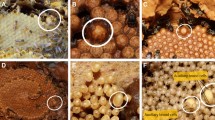Abstract
Parthenogenesis is reported in three soft scales with 2n=16. In the unfertilized eggs of all three, oogenesis is normal and diploidy is restored by the fusion of the division products of the haploid female pronucleus. In Lecanium putmani Phillips 12 of 13 uninseminated females collected in the wild produced only males. The 21 inseminated females produced 15% males. The males were diploid but contained one euchromatic (E) and one heterochromatic (H) chromosome set. Most of the eggs produced by the inseminated females contained sperm but a few did not. It was concluded, therefore, that females develop from fertilized eggs and males from unfertilized eggs and that the species was diploid arrhenotokous. In L. cerasifex Fitch only 18 of 56 females collected in the wild had been inseminated. The frequency of males among their embryos was 22%. The males were again diploid with one E and one H set of chromosomes. Among the 38 uninseminated females, 27 produced only males, and 10 produced only females. All the female producers contained needle-like bacterial symbionts. Most of the male producers, and most of the inseminated females contained no symbionts; the rest contained rod-like symbionts. It was concluded, therefore, that the females of L. cerasifex studied belonged to two races, a diploid arrhenotokous race and an obligate automictic thelytokous race. Eucalymantus tessellatus (Signoret) is obligate automictic thelytokous. All the females examined were uninseminated and produced only females.
Similar content being viewed by others
References
Benedek, T., Specht, G.: Mykologisch-bakteriologische Untersuchungen über Pilze als Symbointen in Kerbtieren. Zbl. Bakt. 130, 74–90 (1933).
Berlowitz, L.: Correlation of genetic activity, heterochromatization, and RNA metabolism. Proc. nat. Acad. Sci. (Wash.) 53, 68–73 (1965).
Brown, S. W.: The Comstockiella system of chromosome behavior in the armored scale insects (Coccoidea: Diaspididae). Chromosoma (Berl.) 14, 360–406 (1963).
Brown, S. W.: Developmental control of heterochromatization in coccids. Genetics 61, Suppl., 191–198 (1969).
Brown, S. W., Nelson-Rees, W. A.: Radiation analysis of the lecanoid genetic system. Genetics 46, 983–1007 (1961).
Buchner, P.: Endosymbiosis of animals with plant microorganisms. New York: Interscience Publishers (1965).
Habib, A.: The male Eulecanium corni Bouché (Hemiptera-Homoptera: Coccoidea-Coccidae). Bull. Soc. Ent. Egypte 40, 119–126 (1956).
Hamilton, W. D.: Extraordinary sex ratios. Science 156, 477–488 (1967).
Hughes-Schrader, S.: Cytology of coccids (Coccoidea: Homoptera). Advanc. Genet. 2, 127–203 (1948).
Kitchin, R. M.: A radiation analysis of a Comstockiella chromosome system: Destruction of heterochromatic chromosomes during spermatogenesis in Parlatoria oleae (Coccidea: Deaspididae). Chromosoma (Berl.) 31, 165–197 (1970).
Nur, U.: Meiotic parthenoginesis and heterochromatization in a soft scale, Pulvinaria hydrangeae (Coccoidea: Homoptera). Chromosoma (Berl.) 14, 123–139 (1963).
Nur, U.: Reversal of heterochromatization and the activity of the paternal chromosome set in the male mealy bug. Genetics 56, 375–389 (1967)a).
Nur, U.: Chromosome systems in the Eriococcidae (Coccoidea Homoptera). II. Gossyparia spuria and Eriococcus araucariae. Chromosoma (Berl.) 22, 151–163 (1967)b).
Nur, U.: Parthenogenesis in coccids (Homoptera). Amer. Zoologist 11, 301–308 (1971).
Pesson, P.: Description du male de Pulvinaria mesembryanthemi Vallot et observations biologiques sur cette espèce (Hemipt. Coccidae). Ann. Soc. Entomol. France 110, 71–77 (1941).
Phillips, J. H. H.: Notes on species of Lecanium Burmeister (Homoptera: Coccoidea) in the Niagra Peninsula, Ontario, with a description of a new species. Canad. Entomol. 97, 231–238 (1965)a).
Phillips, J. H. H.: Biological and behavioral differences between Lecanium cerasifex Fitch and Lecanoum putmani Phillips (Homoptera: Coccoidea). Canad. Entomol. 97, 303–309 (1965)b).
Schrader, F.: The chromosomes of Pseudococcus nipae. Biol. Bull. 40, 259–270 (1921).
Schrader, F.: Experimental and cytological investigations of the life-cycle of Gossyparia spuria (Coccidae) and their bearing on the problem of haploidy in males. Z. wiss. Zool. 134, 149–179 (1929).
Schrader, F., Hughes-Schrader, S.: Haploidy in metazoa. Quart. Rev. Biol. 6, 411–438 (1931).
Snow, R.: Alcoholic hydrochloric acid-carmine as a stain for chromosomes in squash preparations. Stain Technol. 38, 9–13 (1963).
Thomsen, M.: Studien über die Parthenogenese bei einigen Cocciden und Aleurodiden. Z. Zellforsch. 5, 1–116 (1927).
Thomsen, M.: Sex determination in Lecanium. Trans. IVth Internat. Congr. Entomol. 2, 18–24 (1929).
Walczuch, A.: Studien an Coccidensymbionten. Z. Morph. Ökol. Tiere 25, 623–729 (1932).
Author information
Authors and Affiliations
Additional information
Supported by Grant GB 23665 from the National Science Foundation, Washington, D.C.
Rights and permissions
About this article
Cite this article
Nur, U. Diploid arrhenotoky and automictic thelytoky in soft scale insects (Lecaniidae: Coccoidea: Homoptera). Chromosoma 39, 381–401 (1972). https://doi.org/10.1007/BF00326174
Received:
Issue Date:
DOI: https://doi.org/10.1007/BF00326174




